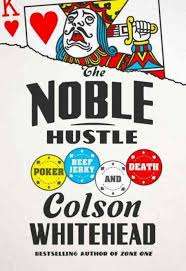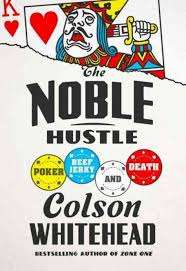The Sunday Review: The Noble Hustle, by Colson Whitehead
Rewalking literary paths first trod by others seldom works well, even for gifted writers. Colson Whitehead’s recent nonfiction book about a first-time visit to the World Series of Poker main event, “The Noble Hustle: Poker, Beef Jerky and Death,” is the tale of Whitehead’s trip to the Rio in Vegas and the WSOP, the offshoot of a shorter piece Whitehead served up for Grantland and ESPN, the corporate megaliths that paid his way.
 “The Noble Hustle” is a book that’s been panned in general and savaged within the poker world in particular, but that’s more a case of a lot of poker people wanting this book to be something different, something more. Whitehead’s visit to poker’s Mecca isn’t so much horrible as it is empty in the final telling: It’s just a misappropriate welding of his laid back, deadpan style to an event and scenario that absolutely depends on adrenaline and suspension of reality to really understand what makes it tick.
“The Noble Hustle” is a book that’s been panned in general and savaged within the poker world in particular, but that’s more a case of a lot of poker people wanting this book to be something different, something more. Whitehead’s visit to poker’s Mecca isn’t so much horrible as it is empty in the final telling: It’s just a misappropriate welding of his laid back, deadpan style to an event and scenario that absolutely depends on adrenaline and suspension of reality to really understand what makes it tick.
It’s no surprise, really, that this book doesn’t work. And how the story evolved from a short-form Grantland feature to a throwaway of a book is itself a part of the failing.
Whitehead’s far from the first to try the “poker novice goes to the WSOP” schtick. The first, groundbreaking tale of its ilk was Al Alvarez’s “The Biggest Game in Town,” with Anthony Holden’s “Big Deal” charting similar ground in shining a broad life into the unusual world of high-stakes poker. Later, about a decade ago, came James McManus’s “Positively Fifth Street,” a Tom Wolfe-styled personal memoir that for my money is the best of the batch.
Whitehead’s acknowledges Alvarez’s and McManus’s earlier efforts, even as it traces a similar arc to “Fifth Street”: Writer gets a gig involving the WSOP, though in Whitehead’s case, the entry fee itself was his compensation for doing the piece.
That’s where the book enters the scene. Whitehead busted the 2011 main event on Day 2B after nitting it up for a day and a half at the tables before exiting on a bad beat, his AA going down to a larger stack’s KK. Fortunately, the book spares its readers more than just a page or two of typical bad-beat lamenting, all part and parcel of an overlight tome in which the poker itself gets short shrift.
“The Noble Hustle” is really this: A tale of an unexceptional Main Event experience, padded up from a feature magazine article into something marketable at book length. It’s a few thousand words of real meat, sandwiched within a couple hundred pages of Whitehead’s deadpan filler. Clara Peller woulda said, “Where’s the beef?”
The missing beef, in this case, is enthusiasm. No amount of slick writing can cover up the fact that this is a thin tale of as ordinary an experience as one could have while playing a first WSOP main event. That wasn’t new, and beyond that, there wasn’t much story to sell.
So what -is- “The Noble Hustle?” Navel gazing. Then some more navel gazing. And a bit more navel gazing after that. There’s also, hidden behind the pages of “The Noble Hustle,” a shadowy elitist mentality, spun a bit by Whitehead via his repeated references and imaginary asides to his “country,” the Republic of Anhedonia.
Anhedonia, as readily defined by Whitehead, is the inability to experience pleasure. Thus arrives the greater joke: in the not-experiencing-pleasure mode Whitehead defines for himself as the theme of this first-person tale, he then commits a major literary sin, in denying his readers their reading pleasure as well… while still charging them for the privilege. Better he should’ve retired the project before doing the book, but hey, someone had to pay for his time expense.
Whitehead also has a fondness for tossing big words, so here’s another: Schadenfreude, meaning pleasure derived from the misfortune of others. Peddling two hundred-plus pages of offhanded self-pity certainly counts.
Perhaps for Whitehead, his WSOP experience was indeed poker, beef jerky and death. But for this readers, who end up paying for the joke, it’s more a case of “Schadenfreude Meets Shutters”. That’s the real name of the famed “Hooker Bar” at the Rio, which Whitehead duly visits and references but can’t quite name.
There are still some good points to the book. If one can understand and relate to Whitehead’s overly deprecating approach, then a few of the anecdotes will bring chuckles. Whitehead has a wonderfully measured writer’s voice and the ability to craft wild flights of imagination which outclass his more ordinary eye for detail.
The poker here is humdrum at best. Despite being more a fan of the game and of card games in general than he wants to admit, Whitehead labors to explain some of poker’s points in a mainstream way. There’s no serious strategy, except for the pages devoted to declaring himself largely deaf to the teachings of the various poker master strategists he encounters along the way.
It’s hard to see exactly who the target audience is for the book. Poker aficionados don’t need the book. The mainstream already has better first-person crossovers regarding poker and the WSOP, from Alvarez and McManus. That just leaves fans of Colson Whitehead and his dry, deprecating style.
The rest of us should wait for better. Or at least different.




















COMMENTS